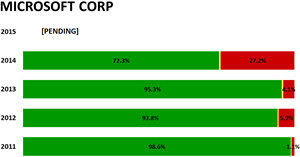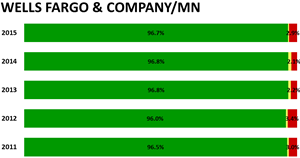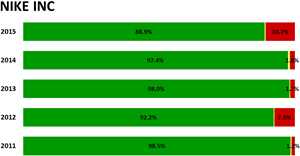|
THE
WALL STREET JOURNAL.
Markets |
Stocks |
Abreast of the Market
Is the Surge in Stock Buybacks Good or Evil?
Companies are on track to purchase the highest number of their own
shares since the crisis
By
E.S. Browning
Updated Nov. 22, 2015 9:17
p.m. ET
Corporate stock buybacks are climbing toward a
post-financial-crisis high this year, furthering the debate about the
use of hundreds of billions of dollars in company cash to enhance
quarterly earnings reports.
Stock repurchases boost earnings per share, even if total earnings don’t
change, by reducing the number of shares. Analysts and investors typically
track per-share earnings, not overall earnings.
Buybacks have drawn criticism from some fund managers including
Larry Fink, chief executive of BlackRock Inc., which oversees $4.5
trillion in assets. He has said some companies invest too much in buybacks
and too little in longer-term business growth. Repurchases also have
become a political issue. Democratic presidential candidate
Hillary Clinton has called for more-frequent and fuller disclosure of
them by the companies involved, even as some activist investors push for
more buybacks as a way of returning cash to investors.
In the year’s first nine months, U.S. companies spent $516.72 billion
buying their own shares, with third-quarter reports still not complete,
according to Birinyi Associates. That is the highest amount for the first
three quarters since the record year of 2007, the year before the
financial crisis. It leaves this year on track for a post-2007 high if
fourth-quarter buybacks hold up.
Buybacks can have a significant impact on earnings, as was illustrated
this quarter by companies including
Microsoft Corp.,
Wells Fargo
& Co.,
Pfizer Inc.
and
Express Scripts Holding Co.
Microsoft turned a
decline in total earnings into a per-share gain by repurchasing a little
more than 3% of its shares in the past 12 months. Its total third-quarter
earnings were down 1.3% from a year earlier, but per-share earnings rose
3.1%, according to FactSet.
For Wells Fargo, a 0.6% increase in total earnings became a 2.9% gain in
earnings per share after buybacks. At Pfizer, a 2% overall earnings gain
became a 5.3% per-share jump. Express Scripts, a large drug-benefits
manager, turned a 2.8% overall gain into a 12.4% per-share increase.
Apple
Inc.
is by far the biggest buyback spender this year, with
$30.22 billion, followed by Microsoft,
Qualcomm Inc.
and
American International Group Inc.
|

Most of the
heaviest buyers of their own shares have seen their stock prices
rise this year, including Apple, which is up 8.1%.
Photo:
STEPHEN
LAM/REUTERS
|
|
This year isn’t on pace to surpass 2007 in total buybacks. But Birinyi’s
data show that announcements of planned future buybacks are the highest
for any year’s first 10 months, more even than in 2007.
“If companies execute their plans, we are looking at a record amount being
deployed over the next couple of years,” said Birinyi analyst Robert
Leiphart.
Some analysts have said for years that the buyback pace will slow, but
there is little sign of that.
Nike Inc.
on Thursday announced plans for up to $12 billion in
buybacks over the next four years, following an $8 billion program that
ends next May.
With corporate cash levels near records and interest rates low, use of
cash or debt to finance buybacks is becoming widespread.
“More than 20% of all companies in the S&P 500 reduced share count by at
least 4%” over the 12 months through the third quarter, said Howard
Silverblatt, senior index analyst at S&P Dow Jones Indices. It marked the
seventh quarter in a row that at least 20% of S&P 500 companies reported
that kind of share reduction. A buyback of 4% or more can have a
noticeable impact on earnings per share, Mr. Silverblatt said.
He calculates that about 12% of S&P 500 companies already have bought so
many shares that, even if their total fourth-quarter earnings don’t rise
and they buy no more shares, their fourth-quarter earnings per share will
be up at least 4%, due simply to reduced share count.
Last year, he said, he calculated that S&P 500 companies got a return of
about 1.3% on cash they held, which put pressure on them to put the money
to work.
Buybacks sometimes can push up a company’s stock price simply by boosting
demand. Most of the heaviest buyers of their own shares have seen their
stock prices rise this year, with Apple up 8.1% and Microsoft up 16.7%.
But Qualcomm is down 33.2% this year,
Oracle Corp.
has retreated 12.5% and biotechnology company
AbbVie Inc.
has fallen 6.6%.
Some critics have complained that buybacks also can represent a hidden
cost of using stock awards or options as executive pay. When issuing stock
to executives, companies typically buy back shares in the market to keep
share count from rising. They don’t typically announce the buybacks as a
compensation cost, analysts say.
Some analysts would like companies to be more forthcoming. Currently,
buybacks permit managers to receive “more of a company’s cash flow than is
reported as compensation on the income statement,” said an October study
by Research Affiliates, a research firm and investment-products designer
in Newport Beach, Calif.
Mark Clements, one of the authors of the Research Affiliates report, noted
that managers’ pay also sometimes depends on gains in earnings per share,
which can provide a further temptation to initiate buybacks.
More generally, critics have said that buybacks represent an artificial,
short-term method of boosting profits. Some companies have made large
buybacks in quarters when earnings were soft, leading to complaints that
they were simply managing earnings.
In a letter this year to companies in which BlackRock invests, Mr. Fink,
the CEO, wrote that “more and more corporate leaders” are taking “actions
that can deliver immediate returns to shareholders, such as buybacks or
dividend increases, while underinvesting in innovation, skilled workforces
or essential capital expenditures necessary to sustain long-term growth.”
Write to
E.S. Browning at
jim.browning@wsj.com
Corrections & Amplifications
An earlier version of a chart running with this article incorrectly
indicated that the stock buybacks shown for all U.S. companies were
through Nov. 20 of each year. They were through Sept. 30.
|












